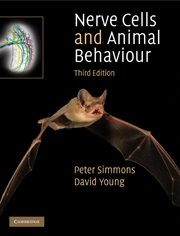Book contents
- Frontmatter
- Contents
- Preface
- 1 Organisation of animal behaviour and of brains: feeding in star-nosed moles and courtship in fruit flies
- 2 Signals in nerve cells: reflexes in mammals and insects
- 3 Neuronal mechanisms for releasing behaviour: predator and prey – toad and cockroach
- 4 Neuronal pathways for behaviour: startle behaviours and giant neurons in crayfish and fish
- 5 Eyes and vision: sensory filtering and course control in insects
- 6 Sensory maps: hunting by owls and bats
- 7 Programmes for movement: how nervous systems generate and control rhythmic movements
- 8 Changes in nerve cells and behaviour: learning in bees and rats; swarming in locusts
- 9 Nerve cells and animal signalling: songs of crickets, electric fish and birds
- References
- Index
- References
1 - Organisation of animal behaviour and of brains: feeding in star-nosed moles and courtship in fruit flies
Published online by Cambridge University Press: 05 August 2012
- Frontmatter
- Contents
- Preface
- 1 Organisation of animal behaviour and of brains: feeding in star-nosed moles and courtship in fruit flies
- 2 Signals in nerve cells: reflexes in mammals and insects
- 3 Neuronal mechanisms for releasing behaviour: predator and prey – toad and cockroach
- 4 Neuronal pathways for behaviour: startle behaviours and giant neurons in crayfish and fish
- 5 Eyes and vision: sensory filtering and course control in insects
- 6 Sensory maps: hunting by owls and bats
- 7 Programmes for movement: how nervous systems generate and control rhythmic movements
- 8 Changes in nerve cells and behaviour: learning in bees and rats; swarming in locusts
- 9 Nerve cells and animal signalling: songs of crickets, electric fish and birds
- References
- Index
- References
Summary
What is special about animal behaviour? Many people like watching animals behave, and an understanding of animal behaviour has been vital throughout human history, enabling people to hunt, to farm, and to understand something about themselves. More recently, understanding how the brains of animals work has given important information about how the human brain works, and why it sometimes malfunctions. But although animal behaviour can be complex and even sometimes seems mysterious, it can be understood and appreciated by the same scientific approaches that are used to study other aspects of the structure and function of living organisms. It is shaped by evolution in the same way as anatomical characters, and natural selection acts on animal behaviour by shaping the ways in which nervous systems work.
The ways in which the internal workings of brains control behaviour is the subject of this book and we shall illustrate them by using examples drawn from many different animal groups. There are several reasons for this catholic approach, but two are particularly important. First, some animals have nervous systems that are especially favourable for study. For example, nervous systems of invertebrates usually contain smaller numbers of nerve cells than those of mammals, so it is much more possible to trace the flow of signals from cell to cell within these simpler nervous systems. In some cases, there are particularly large nerve cells that are especially easy to study, such as the giant neurons involved in escape responses described in Chapters 3 and 4.
- Type
- Chapter
- Information
- Nerve Cells and Animal Behaviour , pp. 1 - 20Publisher: Cambridge University PressPrint publication year: 2010



